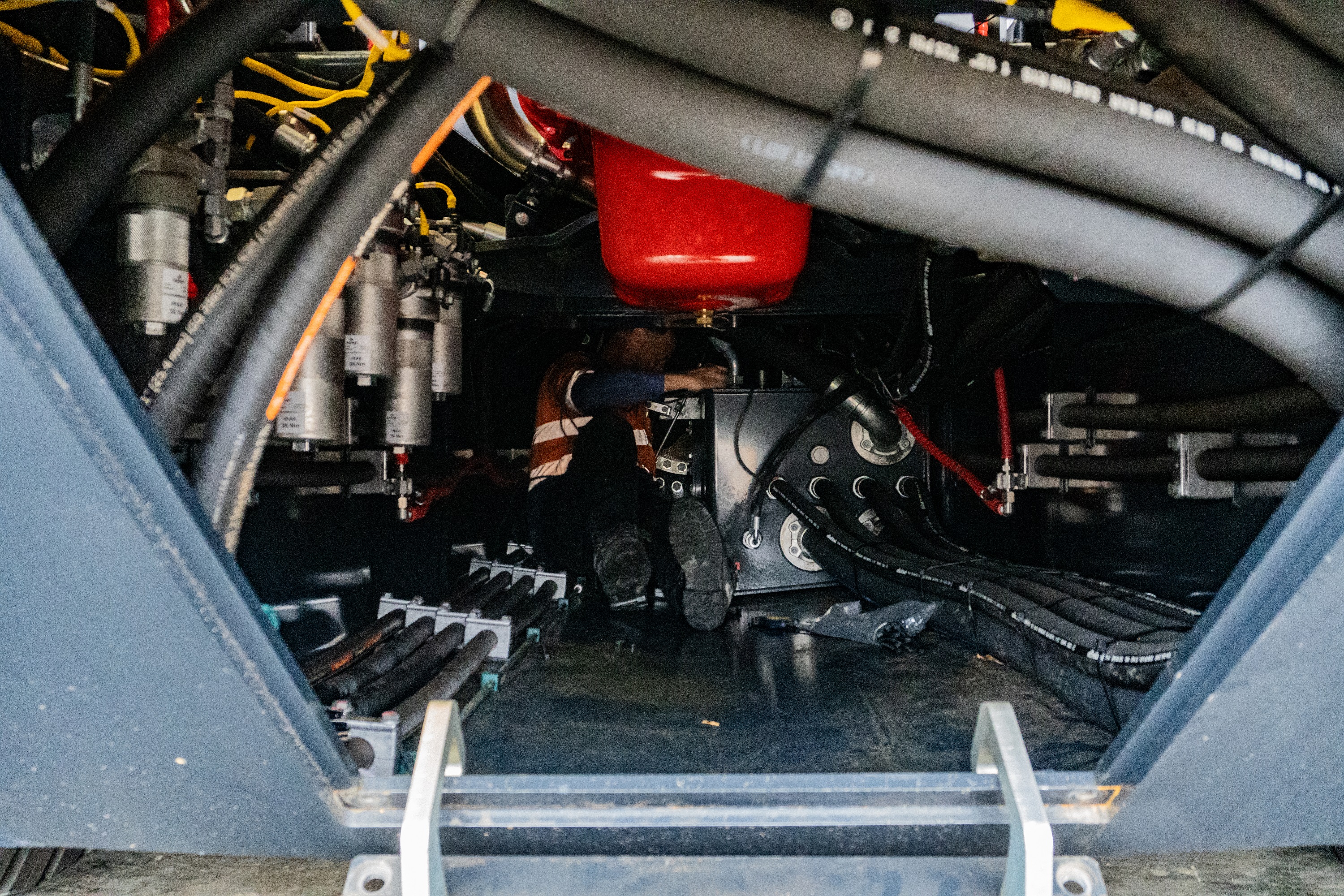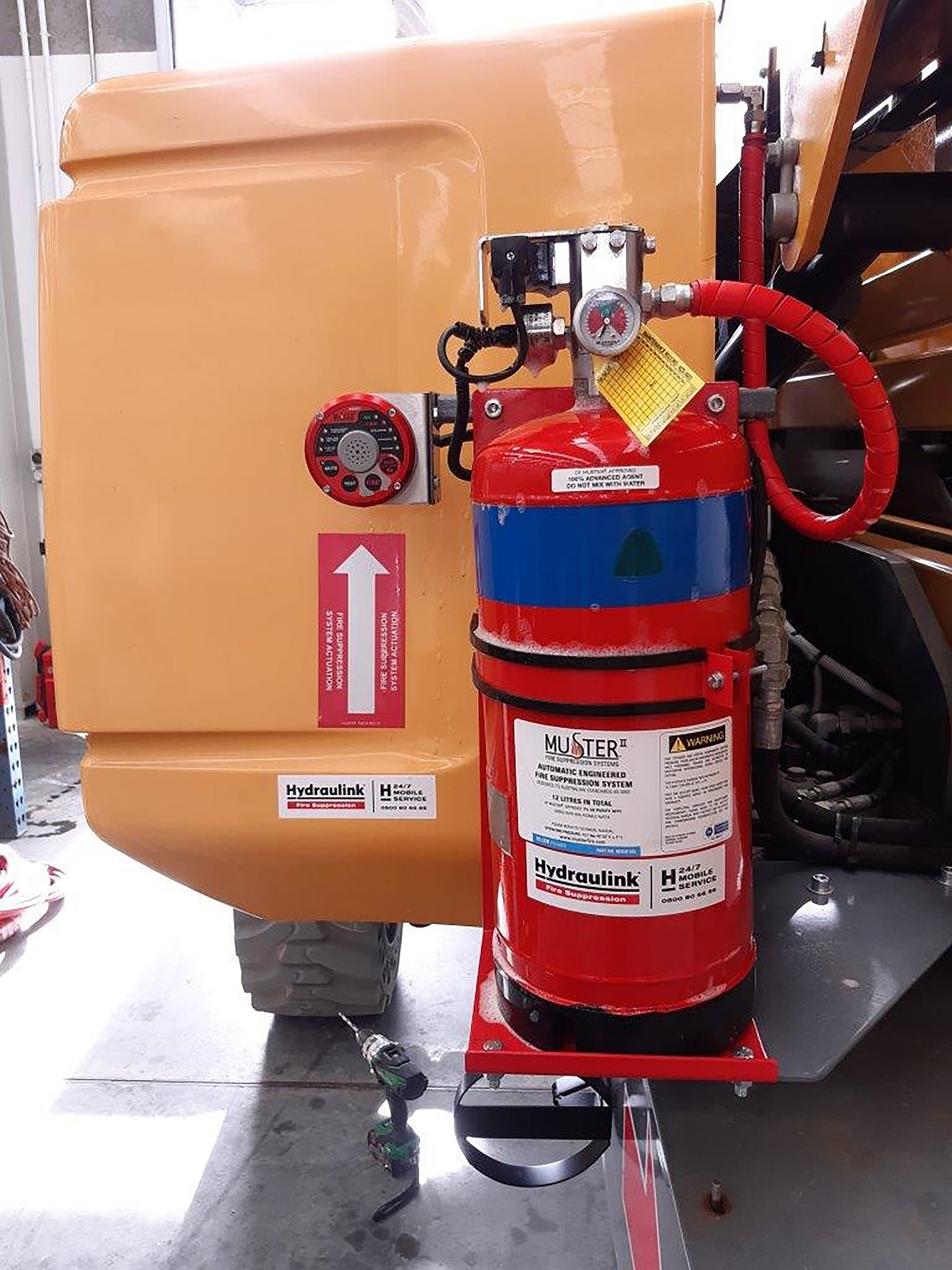24/7 Hydraulink fire suppression technology protects plant and operators of Porter Group’s first BOMAG BC1173RB-5 waste compactors

BOMAG waste compacters. Operators of the first 55-ton Model BC1173RB-5 in Australasia report reduced waste volume at landfill because of extra compaction. The Muster fire suppression system installed by Hydraulink is active 24/7, to protect operators, the
Immediately-responsive 24/7 fire suppression technology has been installed by Hydraulink for the leading heavy equipment Porter Group’s first BOMAG BC 1173 refuse compactors to be introduced to Australasia.
The fluorine-free Muster F3 foam system features its own bult-in electrical power system and self-maintenance features to ensure it functions whenever and wherever it is needed, either at work, parked on-site or based in its user’s workshop.
“Regardless of when and where this valuable plant is located, its fire suppression technology offers immediate protection to owners and operators. Importantly, it is engineered to curtail fire hazards before they spread, preventing any hazard becoming more unsafe and damaging to personnel, machine, and surrounding facilities,” said Hydraulink New Zealand national fire suppression specialist Eric Karlsson.
The Muster fire suppression system used is tailored to markets where safety and operational compliance are paramount, including particularly underground mining and tunnelling as well as steel and metals processing, highway and roads, agricultural, forestry, waste management, construction, defence, and anywhere that machinery works could lead to a fire and damage equipment, stock, or put lives in danger.

Neatly Custom-engineered even in the most inaccessible of places, Hydraulink’ s extensive range of fire suppression systems – including this latest BOMAG installation – provides an optimum solution regardless of location or type of machine
“Our Muster fire suppression systems are designed to detect and activate automatically in the case of fire. They also feature manual activation via a remote actuator that can be placed anywhere appropriate on your site for maximum safety.
“Running expensive machinery is vital for the productivity of a business, and being prepared for a worst-case scenario should always be a standard business practice to ensure the safety of both the company and staff. Engines, hydraulic systems, fuel lines, and electric installations can potentially be a significant fire risk where, once ignited, fires can quickly become out of control and difficult to suppress with handheld extinguishers, for example” says Michael Steward – Hydraulinks’ National Industrial Manager .
Hydraulink Fire Suppression, which services all of New Zealand, specifies Fluorine-free F3 foam on all new pre-engineered fire suppression installations, because it is more environmentally friendly, and safer for workers and machinery operators, says Eric, who worked with Hydraulink colleague Damon Ashworth on the latest of several BOMAG BC 55-ton BC1173RB-5 compactors being introduced by the Porter heavy equipment sales and rental group.
Eric says the fire suppression system engineered for the BOMAG refuse compactors had to be up to the engineering standards of compactors that are some of the most advanced of their type in New Zealand and Australia.
“Their design is engineered to advance environmental objectives by achieving the best possible use of landfill volume, and at the same time offer ideal and homogeneous compaction. This ensures the optimum stability of a landfill site.
“The fire suppression system has to be rugged and versatile, because the BOMAGs from Porter Group can be used on landfill sites of all sizes and types, regardless of whether the refuse is industrial, household, bulky, or construction waste.
“The BC 1173s are packed full of advanced time saving and efficiency technology, such as BOMAG TELEMATIC computerised remote monitoring, which provides location and operating data by the click of a mouse at any time to manage fleets more efficiently. Automatic reports provide full transparency on fuel consumption, idle times, and the potential for fleet optimisation. BOMAG TELEMATIC also includes real-time monitoring of pending maintenance and service history.
“To complement the advanced technology built into the BC1173RB-5s being introduced by Porter Group, we engineered into them a Muster fire suppression system that integrates perfectly with the 24/7 monitoring and automation of the vehicle and provides a gold standard of protection and compliance for advanced machinery that increasingly is automated and digitised.”
“All Muster systems installed by Hydraulink are AS5062 compliant, which means that all installations and all products abide by strict quality assurance practices, so customers are assured of a quality system, installed by trained staff, and maintained for the lifetime of the product,” said Eric.
“Such high standards are integral to the operations of leading companies such as the Porter Group, and important also to world-class clients with whom we deal, including mining, transport, and tunnelling operations where fire suppression is doubly important.”
Linear Heat Detection
Hydraulink Fire Suppression utilises Linear Heat Detection (LHD) to further minimise costs and downtime for customers. The major advantage of using LHD, is that there is no leakage of gas through the system.
“Most heat detection systems use a Nitrogen filled tube, which melts at a set temperature when exposed to fire. We use a MusterWire LHD system with protective cover over the linear wire the actuates at 180 deg C, which short circuits the wires when fire is detected activating the system. The LHD system also ensures no leakage of gas through the system,” explains Eric.

Regular service with total traceability
All fire suppression systems come with a recommendation to service them annually, with visual inspections at three or six month intervals.
“The exact servicing schedule can be site-specific, and we work to our customers’ preferred schedule, as long as the major service happens at least once a year. We keep total records and registers of all equipment, so that the customer has full traceability and can see the remaining life of the system,” says Eric.
“Traceability is particularly important with fire suppression systems because each will have a finite life. If a fire occurs, you want to know that the system in place will deliver the expected protection for personnel, the particular asset and other surrounding plant. The cost, downtime, and risk to life just isn’t worth it.”


